編輯:關於Android編程
實現zip/tar的壓縮與解壓
java中實際是提供了對 zip等壓縮格式的支持,但是為什麼這裡會用到ant呢?
原因主要有兩個:
1. java提供的類對於包括有中文字符的路徑,文件名支持不夠好,你用其它第三方軟件解壓的時候就會存在亂碼。而ant.jar就支持文件名或者路徑包括中文字符。
2. ant.jar提供了強大的工具類,更加方便於我們對壓縮與解壓的操作。
注意事項:
1. 首先說明一下,關於皮膚或者類似於皮膚的Zip包,實際上公司可能會根據自己的規定或需求,自定義壓縮包文件的結尾,實際上大多還是Zip包的格式. 具體部分的處理大致上是一樣的,因此不再復述, 本文給出的例子已經有Zip包和Tar包的解壓縮.
2. 還有要注意的是,此處為提升理解,因此加入zip/tar壓縮,解壓的界面,實際應用中此部分無需單獨的界面展示(解壓縮需要一定時間的話,則為加強用戶體驗,加入提示框與進度條),請自行編寫解壓縮管理類進行邏輯判斷分別處理.
3. 測試時需要講要解壓縮的包導入sdcard目錄下(若為其他目錄,請修改代碼中路徑)
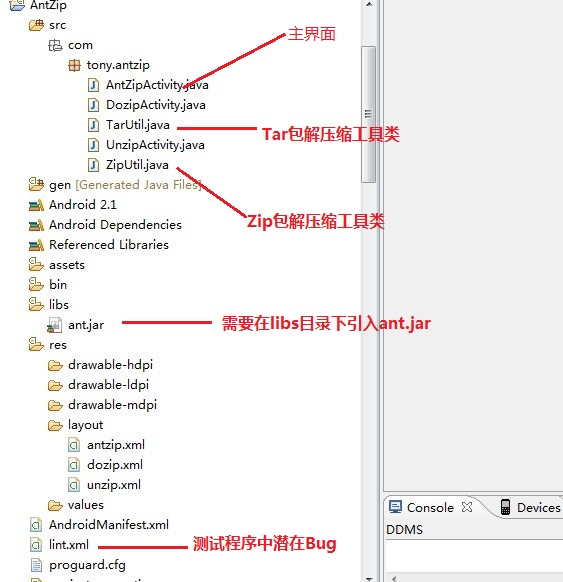
程序主界面及解壓縮的界面:
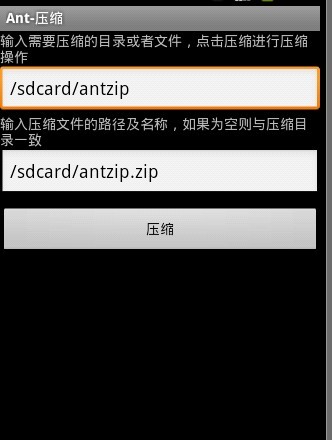
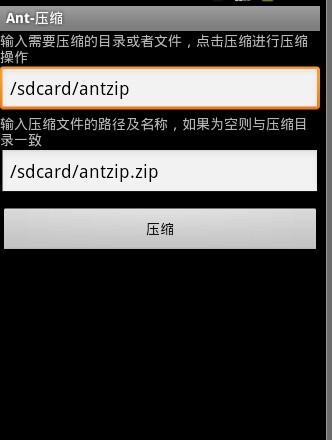
接下來是解壓縮核心的代碼:
布局文件: antzip.xml:
<?xml version="1.0" encoding="utf-8"?>
<RelativeLayout xmlns:android="http://schemas.android.com/apk/res/android"
android:layout_width="fill_parent"
android:layout_height="fill_parent">
<LinearLayout
android:orientation="vertical" android:layout_width="fill_parent"
android:layout_height="wrap_content"
android:gravity="center"
android:padding="20dip"
android:layout_centerInParent="true">
<RadioGroup
android:layout_width="wrap_content"
android:layout_height="wrap_content"
android:orientation="horizontal">
<RadioButton android:layout_width="wrap_content"
android:layout_height="wrap_content"
android:id="@+id/radioZip"
android:checked="true"
android:text="ZIP"/>
<RadioButton android:layout_width="wrap_content"
android:layout_height="wrap_content"
android:id="@+id/radioTar"
android:text="TAR"
android:layout_marginLeft="10dip"/>
</RadioGroup>
<Button android:text="壓縮" android:id="@+id/button1"
android:layout_width="fill_parent" android:layout_height="wrap_content"
android:paddingLeft="30dip" android:paddingRight="30dip"></Button>
<Button android:text="解壓" android:id="@+id/button2"
android:layout_width="fill_parent" android:layout_height="wrap_content"
android:paddingLeft="30dip" android:paddingRight="30dip"
android:layout_marginTop="20dip"></Button>
</LinearLayout>
</RelativeLayout>
AntZipActivity:
public class AntZipActivity extends Activity {
public static final String TYPE = "type";
public static final int TYPE_ZIP = -1;
public static final int TYPE_TAR = 1;
public static final String SUFFIX_ZIP = ".zip";
public static final String SUFFIX_TAR = ".tar";
/** Called when the activity is first created. */
private Button btnDoCompress;
private Button btnDecompress;
private RadioButton radioZip;
private RadioButton radioTar;
private boolean isZip = true;
@Override
public void onCreate(Bundle savedInstanceState) {
super.onCreate(savedInstanceState);
setContentView(R.layout.antzip);
radioZip = (RadioButton)findViewById(R.id.radioZip);
isZip = true;
radioZip.setChecked(true);
radioZip.setOnCheckedChangeListener(new OnCheckedChangeListener() {
@Override
public void onCheckedChanged(CompoundButton buttonView, boolean isChecked) {
System.out.println("radioZip:"+isChecked);
if(isChecked)
{
isZip = true;
}
}
});
radioTar = (RadioButton)findViewById(R.id.radioTar);
radioTar.setOnCheckedChangeListener(new OnCheckedChangeListener() {
@Override
public void onCheckedChanged(CompoundButton buttonView, boolean isChecked) {
System.out.println("radioTar:"+isChecked);
if(isChecked)
{
isZip = false;
}
}
});
btnDoCompress = (Button)findViewById(R.id.button1);
btnDoCompress.setOnClickListener(new OnClickListener() {
@Override
public void onClick(View v) {
//進入壓縮界面
Intent i = new Intent(AntZipActivity.this,DozipActivity.class);
i.putExtra(TYPE, isZip?TYPE_ZIP:TYPE_TAR);
AntZipActivity.this.startActivity(i);
}
});
btnDecompress = (Button)findViewById(R.id.button2);
btnDecompress.setOnClickListener(new OnClickListener() {
@Override
public void onClick(View v) {
//進入解壓界面
Intent i = new Intent(AntZipActivity.this,UnzipActivity.class);
i.putExtra(TYPE, isZip?TYPE_ZIP:TYPE_TAR);
AntZipActivity.this.startActivity(i);
}
});
}
}
DozipActivity:
public class DozipActivity extends Activity implements OnClickListener{
private EditText etPath;
private EditText etDest;
private Button btnDozip;
private TextView tvTip;
private String srcPath;
private String zipDest;
private int type;
private String suffix;
@Override
public void onCreate(Bundle savedInstanceState) {
super.onCreate(savedInstanceState);
setTitle("Ant-壓縮");
type = getIntent().getIntExtra(AntZipActivity.TYPE, AntZipActivity.TYPE_ZIP);
suffix = type==AntZipActivity.TYPE_ZIP ? AntZipActivity.SUFFIX_ZIP:AntZipActivity.SUFFIX_TAR;
setContentView(R.layout.dozip);
//
etPath = (EditText)findViewById(R.id.editText1);
etDest = (EditText)findViewById(R.id.editText2);
//設置一些默認的函數
etPath.setText("/sdcard/antzip");
etDest.setText("/sdcard/antzip"+suffix);
btnDozip = (Button)findViewById(R.id.button);
tvTip = (TextView)findViewById(R.id.tv_tip);
btnDozip.setOnClickListener(this);
}
@Override
public void onClick(View v) {
srcPath = etPath.getEditableText().toString();
if(TextUtils.isEmpty(srcPath))
{
Toast.makeText(this, "請指定一個路徑", Toast.LENGTH_SHORT).show();
return;
}
File srcFile = new File(srcPath);
if(!srcFile.exists())
{
Toast.makeText(this, "指定的壓縮包不存在", Toast.LENGTH_SHORT).show();
return;
}
zipDest = etDest.getEditableText().toString();
if(TextUtils.isEmpty(zipDest))
{
//如果用戶沒有輸入目標文件,則生成一個默認的
zipDest = srcFile.getParent();
}
System.out.println("zip name:"+zipDest);
//如果是以/結尾的,則證明用戶輸入的是一個目錄 ,需要在後面加上文件名
if(zipDest.endsWith(File.separator))
{
zipDest+=srcFile.getName()+suffix;
}
else
{
//如果壓縮文件名不是以zip/tar結尾,則加上後綴後
if(!zipDest.endsWith(suffix))
{
zipDest +=suffix;
}
}
//如果用戶選擇的是zip,則用 zipUtil進行壓縮
if(type == AntZipActivity.TYPE_ZIP)
{
ZipUtil zipp = new ZipUtil();
zipp.doZip(srcPath, zipDest);
}
//如果用戶選擇的是tar,則用 tarUtil進行壓縮
else
{
TarUtil tarr = new TarUtil();
tarr.doTar(srcPath, zipDest);
}
//壓縮完成後還是提示用戶
tvTip.setText("壓縮文件路徑:"+zipDest);
Toast.makeText(this, "壓縮完成", Toast.LENGTH_SHORT).show();
}
}
解壓縮工具類ZipUtil:
public class ZipUtil {
private ZipFile zipFile;
private ZipOutputStream zipOut; //壓縮Zip
private int bufSize; //size of bytes
private byte[] buf;
public ZipUtil(){
//要構造函數中去初始化我們的緩沖區
this.bufSize = 1024*4;
this.buf = new byte[this.bufSize];
}
/**
* 對傳入的目錄或者是文件進行壓縮
* @param srcFile 需要 壓縮的目錄或者文件
* @param destFile 壓縮文件的路徑
*/
public void doZip(String srcFile, String destFile) {// zipDirectoryPath:需要壓縮的文件夾名
File zipFile = new File(srcFile);
try {
//生成ZipOutputStream,會把壓縮的內容全都通過這個輸出流輸出,最後寫到壓縮文件中去
this.zipOut = new ZipOutputStream(new BufferedOutputStream(
new FileOutputStream(destFile)));
//設置壓縮的注釋
zipOut.setComment("comment");
//設置壓縮的編碼,如果要壓縮的路徑中有中文,就用下面的編碼
zipOut.setEncoding("GBK");
//啟用壓縮
zipOut.setMethod(ZipOutputStream.DEFLATED);
//壓縮級別為最強壓縮,但時間要花得多一點
zipOut.setLevel(Deflater.BEST_COMPRESSION);
handleFile(zipFile, this.zipOut,"");
//處理完成後關閉我們的輸出流
this.zipOut.close();
} catch (IOException ioe) {
ioe.printStackTrace();
}
}
/**
* 由doZip調用,遞歸完成目錄文件讀取
* @param zipFile
* @param zipOut
* @param dirName 這個主要是用來記錄壓縮文件的一個目錄層次結構的
* @throws IOException
*/
private void handleFile(File zipFile, ZipOutputStream zipOut,String dirName) throws IOException {
System.out.println("遍歷文件:"+zipFile.getName());
//如果是一個目錄,則遍歷
if(zipFile.isDirectory())
{
File[] files = zipFile.listFiles();
if (files.length == 0) {// 如果目錄為空,則單獨創建之.
//只是放入了空目錄的名字
this.zipOut.putNextEntry(new ZipEntry(dirName+zipFile.getName()+File.separator));
this.zipOut.closeEntry();
} else {// 如果目錄不為空,則進入遞歸,處理下一級文件
for (File file : files) {
// 進入遞歸,處理下一級的文件
handleFile(file, zipOut, dirName+zipFile.getName()+File.separator);
}
}
}
//如果是文件,則直接壓縮
else
{
FileInputStream fileIn = new FileInputStream(zipFile);
//放入一個ZipEntry
this.zipOut.putNextEntry(new ZipEntry(dirName+zipFile.getName()));
int length = 0;
//放入壓縮文件的流
while ((length = fileIn.read(this.buf)) > 0) {
this.zipOut.write(this.buf, 0, length);
}
//關閉ZipEntry,完成一個文件的壓縮
this.zipOut.closeEntry();
}
}
/**
* 解壓指定zip文件
* @param unZipfile 壓縮文件的路徑
* @param destFile 解壓到的目錄
*/
public void unZip(String unZipfile, String destFile) {// unZipfileName需要解壓的zip文件名
FileOutputStream fileOut;
File file;
InputStream inputStream;
try {
//生成一個zip的文件
this.zipFile = new ZipFile(unZipfile);
//遍歷zipFile中所有的實體,並把他們解壓出來
for (@SuppressWarnings("unchecked")
Enumeration<ZipEntry> entries = this.zipFile.getEntries(); entries
.hasMoreElements();) {
ZipEntry entry = entries.nextElement();
//生成他們解壓後的一個文件
file = new File(destFile+File.separator+entry.getName());
if (entry.isDirectory()) {
file.mkdirs();
} else {
// 如果指定文件的目錄不存在,則創建之.
File parent = file.getParentFile();
if (!parent.exists()) {
parent.mkdirs();
}
//獲取出該壓縮實體的輸入流
inputStream = zipFile.getInputStream(entry);
fileOut = new FileOutputStream(file);
int length = 0;
//將實體寫到本地文件中去
while ((length = inputStream.read(this.buf)) > 0) {
fileOut.write(this.buf, 0, length);
}
fileOut.close();
inputStream.close();
}
}
this.zipFile.close();
} catch (IOException ioe) {
ioe.printStackTrace();
}
}
}
Ant 實現批量打包Android應用
由於公司運維需要以及應用中需要加上應用推廣的統計,往往要對應二三十個渠道,按照正常方法一個一個的去生成不同渠道包的應用,不僅浪費了時間,而且大大降低了效率.
上一篇講到使用Ant進行Zip/Tar包的解壓縮,實際上Ant工具不僅僅具有此類功能,它更強大的地方在於自動化調用程序完成項目的編譯,打包,測試等. 類似於C語言中的make腳本完成這些工作的批處理任務. 不同於MakeFile的是,Ant是純Java編寫的,因此具有很好的跨平台性.
在此我主要講下如何自動構建工具Ant, 對應用進行批量打包, 生成對應不同市場的應用:
首先分別看一下用於打包的Java工程AntTest和需要被打包進行發布的Android工程結構:

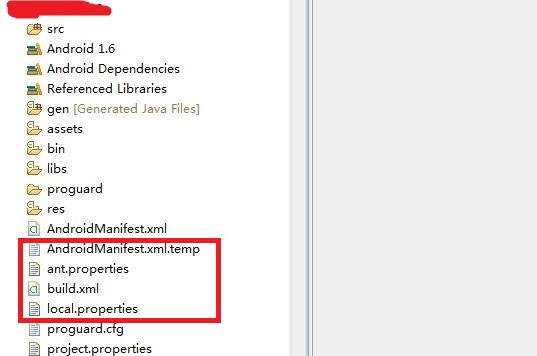
market.txt裡保存需要打包的市場標識,如:
youmeng gfan .......
此文件裡自行根據需求添加渠道名稱.
然後看一下實現批量打包AntTest類中的內容:
注意:紅色標注部分需要進行修改:
package com.cn.ant;
import java.io.BufferedReader;
import java.io.BufferedWriter;
import java.io.File;
import java.io.FileReader;
import java.io.FileWriter;
import java.io.IOException;
import java.text.SimpleDateFormat;
import java.util.Calendar;
import org.apache.tools.ant.DefaultLogger;
import org.apache.tools.ant.Project;
import org.apache.tools.ant.ProjectHelper;
public class AntTest {
private Project project;
public void init(String _buildFile, String _baseDir) throws Exception {
project = new Project();
project.init();
DefaultLogger consoleLogger = new DefaultLogger();
consoleLogger.setErrorPrintStream(System.err);
consoleLogger.setOutputPrintStream(System.out);
consoleLogger.setMessageOutputLevel(Project.MSG_INFO);
project.addBuildListener(consoleLogger);
// Set the base directory. If none is given, "." is used.
if (_baseDir == null)
_baseDir = new String(".");
project.setBasedir(_baseDir);
if (_buildFile == null)
_buildFile = new String(projectBasePath + File.separator
+ "build.xml");
// ProjectHelper.getProjectHelper().parse(project, new
// File(_buildFile));
<span >// 關鍵代碼</span>
ProjectHelper.configureProject(project, new File(_buildFile));
}
public void runTarget(String _target) throws Exception {
// Test if the project exists
if (project == null)
throw new Exception(
"No target can be launched because the project has not been initialized. Please call the 'init' method first !");
// If no target is specified, run the default one.
if (_target == null)
_target = project.getDefaultTarget();
// Run the target
project.executeTarget(_target);
}
<span >private final static String projectBasePath = "D:\\android\\workspace3\\XXX";//要打包的項目根目錄
private final static String copyApkPath = "D:\\android\\apktest";//保存打包apk的根目錄
private final static String signApk = "XXX-release.apk";//這裡的文件名必須是准確的項目名!
private final static String reNameApk = "XXX_";//重命名的項目名稱前綴(地圖項目不用改)
private final static String placeHolder = "@market@";//需要修改manifest文件的地方(占位符)
</span>
public static void main(String args[]) {
long startTime = 0L;
long endTime = 0L;
long totalTime = 0L;
Calendar date = Calendar.getInstance();
SimpleDateFormat sdf = new SimpleDateFormat("yyyy-MM-dd:HH:mm:ss");
try {
System.out.println("---------ant批量自動化打包開始----------");
startTime = System.currentTimeMillis();
date.setTimeInMillis(startTime);
System.out.println("開始時間為:" + sdf.format(date.getTime()));
BufferedReader br = new BufferedReader(new FileReader("market.txt"));
String flag = null;
while ((flag = br.readLine()) != null) {
// 先修改manifest文件:讀取臨時文件中的@market@修改為市場標識,然後寫入manifest.xml中
String tempFilePath = projectBasePath + File.separator
+ "AndroidManifest.xml.temp";
String filePath = projectBasePath + File.separator
+ "AndroidManifest.xml";
write(filePath, read(tempFilePath, flag.trim()));
// 執行打包命令
AntTest mytest = new AntTest();
mytest.init(projectBasePath + File.separator + "build.xml",
projectBasePath);
mytest.runTarget("clean");
mytest.runTarget("release");
// 打完包後執行重命名加拷貝操作
File file = new File(projectBasePath + File.separator + "bin"
+ File.separator + signApk);// bin目錄下簽名的apk文件
File renameFile = new File(copyApkPath + File.separator + reNameApk
+ flag + ".apk");
boolean renametag = file.renameTo(renameFile);
System.out.println("rename------>"+renametag);
System.out.println("file ------>"+file.getAbsolutePath());
System.out.println("rename------>"+renameFile.getAbsolutePath());
}
System.out.println("---------ant批量自動化打包結束----------");
endTime = System.currentTimeMillis();
date.setTimeInMillis(endTime);
System.out.println("結束時間為:" + sdf.format(date.getTime()));
totalTime = endTime - startTime;
System.out.println("耗費時間為:" + getBeapartDate(totalTime));
} catch (Exception e) {
e.printStackTrace();
System.out.println("---------ant批量自動化打包中發生異常----------");
endTime = System.currentTimeMillis();
date.setTimeInMillis(endTime);
System.out.println("發生異常時間為:" + sdf.format(date.getTime()));
totalTime = endTime - startTime;
System.out.println("耗費時間為:" + getBeapartDate(totalTime));
}
}
/**
* 根據所秒數,計算相差的時間並以**時**分**秒返回
*
* @param d1
* @param d2
* @return
*/
public static String getBeapartDate(long m) {
m = m / 1000;
String beapartdate = "";
int nDay = (int) m / (24 * 60 * 60);
int nHour = (int) (m - nDay * 24 * 60 * 60) / (60 * 60);
int nMinute = (int) (m - nDay * 24 * 60 * 60 - nHour * 60 * 60) / 60;
int nSecond = (int) m - nDay * 24 * 60 * 60 - nHour * 60 * 60 - nMinute
* 60;
beapartdate = nDay + "天" + nHour + "小時" + nMinute + "分" + nSecond + "秒";
return beapartdate;
}
public static String read(String filePath, String replaceStr) {
BufferedReader br = null;
String line = null;
StringBuffer buf = new StringBuffer();
try {
// 根據文件路徑創建緩沖輸入流
br = new BufferedReader(new FileReader(filePath));
// 循環讀取文件的每一行, 對需要修改的行進行修改, 放入緩沖對象中
while ((line = br.readLine()) != null) {
// 此處根據實際需要修改某些行的內容
if (line.contains(placeHolder)) {
line = line.replace(placeHolder, replaceStr);
buf.append(line);
} else {
buf.append(line);
}
buf.append(System.getProperty("line.separator"));
}
} catch (Exception e) {
e.printStackTrace();
} finally {
// 關閉流
if (br != null) {
try {
br.close();
} catch (IOException e) {
br = null;
}
}
}
return buf.toString();
}
/**
* 將內容回寫到文件中
*
* @param filePath
* @param content
*/
public static void write(String filePath, String content) {
BufferedWriter bw = null;
try {
// 根據文件路徑創建緩沖輸出流
bw = new BufferedWriter(new FileWriter(filePath));
// 將內容寫入文件中
bw.write(content);
} catch (Exception e) {
e.printStackTrace();
} finally {
// 關閉流
if (bw != null) {
try {
bw.close();
} catch (IOException e) {
bw = null;
}
}
}
}
}
然後是Android工程中需要進行修改的部分:
1. 修改local.properties中的sdk根目錄:
sdk.dir=D:\\android\\android-sdk-windows-r17\\android-sdk-windows-r17
2. 修改ant.properties中簽名文件的路徑和密碼(如果需要)
key.store=D:\\android\\mykeystore key.store.password=123456 key.alias=mykey key.alias.password=123456
3. 修改AndroidManifest.xml.temp
拷貝AndroidManifest.xml一份,命名為AndroidManifest.xml.temp
將需要替換的地方改為占位符,需與打包工程AntTest中的placeHolder常量一致
如: <meta-data android:value="@market@" android:name="UMENG_CHANNEL"/>
4. Build.xml中:
<project name="XXX" default="help">,XXX必須為Android工程名稱.
如果機器沒有配置過Ant環境變量,可根據如下步驟進行配置:
ANT環境變量設置:
Windows下ANT用到的環境變量主要有2個,ANT_HOME 、PATH。
設置ANT_HOME指向ant的安裝目錄。
設置方法:
ANT_HOME = D:/apache_ant_1.7.0
將%ANT_HOME%/bin; %ANT_HOME%/lib添加到環境變量的path中。
設置方法:
PATH = %ANT_HOME%/bin; %ANT_HOME%/lib
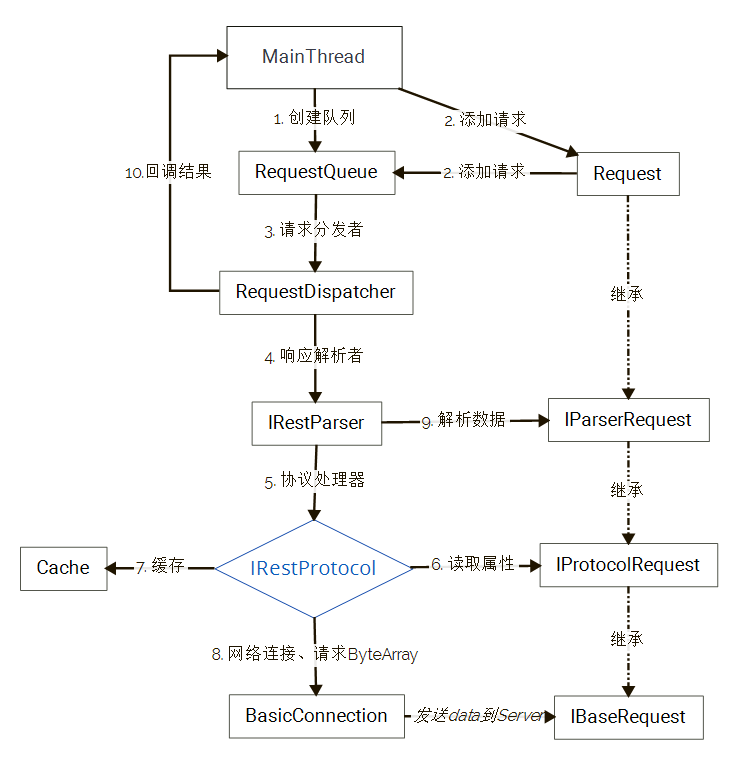 Android NoHttp 框架作者帶你看源碼(一)
Android NoHttp 框架作者帶你看源碼(一)
現在市場的Http框架很多,比如我們熟知的NoHttp、Retrofit、Volley、android-async-http等上層框架,HttpURLConnection
 Android模擬登錄評論CSDN
Android模擬登錄評論CSDN
有時候作為非官方開發的APP集成了官方的所有信息,但是現在需要實現另一個功能那就是登錄發表評論到官方的網站,而非官方的APP並不知道官方網站是怎麼實現登錄與評論的,而且越
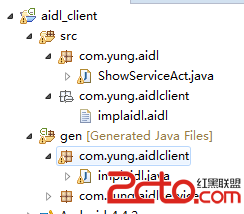 安卓最簡單的aidl用兩個程序模擬進程通信
安卓最簡單的aidl用兩個程序模擬進程通信
最近要面試了 沒 時間玩了.看了下安卓icp ,說實話一直沒過aidl這東東 發現網上帖子好多 下載的卻好少 .好吧自己玩了一個 留下做個備注吧. 服務端輸入文
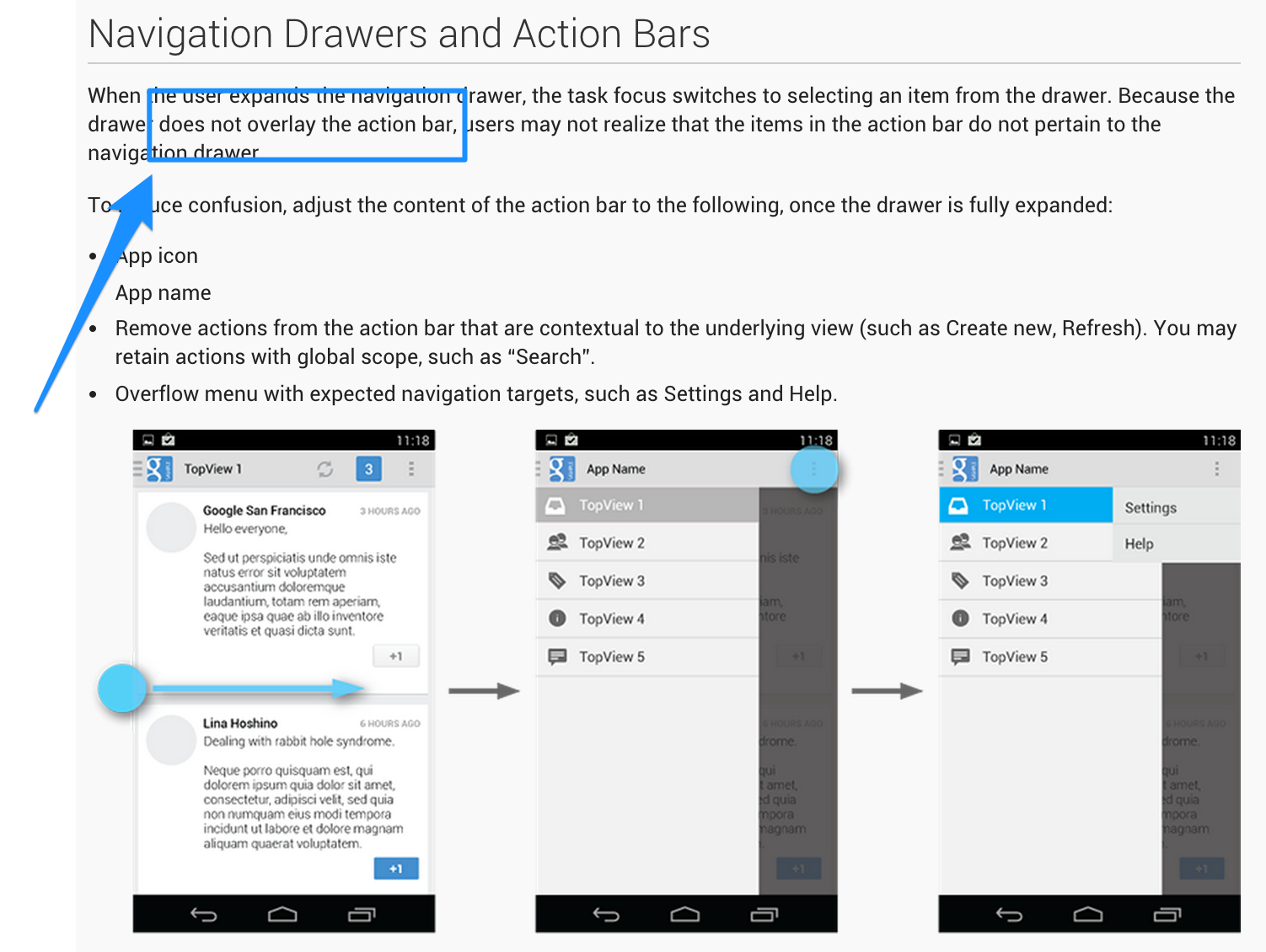 Android 滑動導航菜單的快速構建(二) Material Design
Android 滑動導航菜單的快速構建(二) Material Design
上一篇介紹了幾個滑動導航菜單效果的快速構建,這篇文章來總結“當下”如何按照Android的設計標准去設計滑動導航菜單,我為什麼說的“當